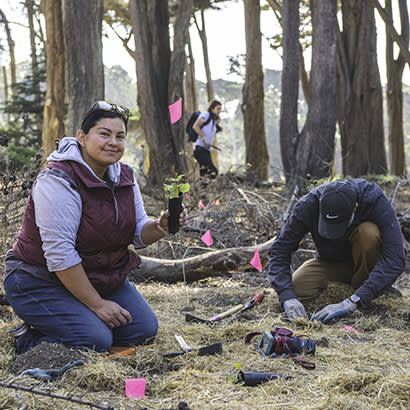
For an enhanced digital experience, read this story in the ezine.
In the fall of 2021, while wildfires raged in California and I mourned the heartbreaking losses to human and nonhuman life due to the coronavirus (COVID-19) pandemic, I read a book titled What Kind of an Ancestor Do You Want to Be? This bold, radical and powerful invitation tugged at my weak heart, and slowly hope started to strengthen me from within. I was reminded of a stewardship program we hosted pre-pandemic to celebrate Día de los Muertos (Day of the Dead), a festival of remembering those who have passed away, and Diwali, a festival of light and hope. The trailhead was transformed into an altar (ofrenda), where participants placed photos and sentimental objects of loved ones they had lost. Marigolds, colorful paper flowers and diyas (an oil lamp made of clay) cast a warm and welcoming glow. We exchanged stories about rituals around life and death and made a promise to spread hope and light beyond this program. Plants were planted in memory of loved ones who had passed, and now, many participants come back to that park site to say hello to the Seaside daisies and Yarrow they had planted.
When people see themselves — their cultures, languages and identities — reflected in a park, they come back. The connection moves beyond an initial introduction to a sense of belonging.
For example, when Golden Gate National Parks Conservancy and National Park Service staff sent an invitation to our communities in observance of the Festival of Eid (an event marking the end of Ramadan) — as part of a habitat restoration volunteer program — it brought not just people from within local Muslim communities, but also a diverse group of people who showed up to learn and offer support, including the park’s regular volunteers. This gathering and many others like these over the years have given us new ways of bringing our communities into a conversation about culture, traditions, rituals, beliefs and faith as metaphors for deepening our relations with each other.
Sweet exchanges like “Eid Mubarak!” filled the air at this program. When a personal language or mother tongue is shared out loud, there’s an immediate connection to a place and people, and a sense of comfort and home. A welcome table at the entrance was decorated with books and artwork by authors, poets and artists from the community. Henna cones placed in a bowl invited participants to engage in art inspired by local flora and fauna. We gathered in a circle, and respectfully engaged our multicultural and inter-generational group in an interpretive talk on the environmental spirit of Islam. We invited our participants to reflect, observe and listen along with us.
In an age of so many competing demands from life, our participants had chosen to give their time to nurture the park site. We picked up our tools and started our habitat restoration work while participants shared their stories of nature connections. At break time, a bowl of sweet sheer khurma was enjoyed by all. A young Muslim girl in a hijab offered to draw a monarch butterfly with the henna cone on the hand of a new park friend.
My inspiration to try this approach — connecting ecology, conservation, restoration and discussions about climate change to culture and spirituality — is inspired by observing Indigenous people in India, Nepal and now here in the United States. In my home state of Maharashtra, India, I was introduced to the Warli tribe’s symbiotic and mutually beneficial relationship with all beings through art. Their paintings depict a collective way of living, centering the nonhuman world in everything they do. For this to happen, it takes a lifelong practice of thinking about our everyday actions and activities — in our work, our homes, our community gathering spaces and our relationships — and how they are intrinsically connected to the nonhuman life we cohabitate with. Can parks become the points of entry for the beginning of these lifelong practices? As we grapple with everyday challenges due to climate change and social inequities, can park programs become spaces for communities to come together, and find hope and inspiration to confront these challenges?
At dawn and dusk every day, I go back to the invitation — What kind of an ancestor do I want to be? I want to be an ancestor who creates park programs such as these, where love, compassion and joy grow and become the tools we can use to embrace the challenges that are still to come.
Yakuta Poonawalla is the Associate Director for the Community Stewardship and Engagement Program at the Golden Gate National Parks Conservancy.

